Saxophone
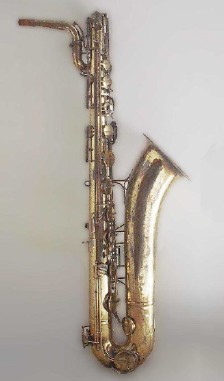
The saxophone or sax is a conical instrument of the woodwind family, usually made of brass and played with a single-reed mouthpiece like the clarinet. It was invented by Adolphe Sax in the mid-1840s. The saxophone is most commonly associated with popular music, big band music, and jazz, but it was originally intended as both an orchestral and military band instrument. Saxophone players are appropriately called saxophonists.
History
The saxophone was created in the mid-1840s by Adolphe Sax, a Belgian-born instrument-maker and clarinetist working in Paris, and was first officially revealed to the public in the patent of 1846 (which was granted to him on May 17). He made 14 different types of saxophones. Sax's amazing ability to offend rival instrument manufacturers, and unfortunate prejudice towards the man and his instruments led to it not being used in orchestral groups, and for a long time it was relegated to military bands--this despite his great friendship with the influential Parisian composer Berlioz.
The inspiration for the instrument is unknown, but there is good evidence that fitting a clarinet mouthpiece to an ophicleide is the most likely origin (doing so results in a definitely saxophone-like sound). Sax worked in his father's workshop for many years, and both clarinets and ophicleides were manufactured there. The Hungarian/Romanian tarogato, which is quite similar to a soprano saxophone, has also been speculated to have been an inspiration. However, this cannot be so, as the modern tarogato with a single reed mouthpiece was not developed until the 1890's, long after the saxophone had been invented. It is likely, however, that Sax's intent was in fact to invent an entirely new instrument which suited his desires both tonally and technically and possessed a new level of flexibility. This would explain why he chose to name the instrument the "voice of Sax."
The development is defined almost entirely in terms of Sax's patent. For the duration of the patent (1846-1866) no one except the Sax factory Paris could legally manufacture or modify the instruments. After 1866 many modifications were introduced by a number of manufacturers.
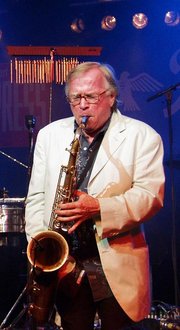
Construction
The saxophone uses a single reed mouthpiece similar to that of a clarinet, but with a round or square evacuated inner chamber. The saxophone's body is effectively conical, giving it properties more similar to the oboe than to the clarinet. However, unlike the oboe, whose tube is a single cone, most saxophones have a distinctive curve at the bell. Straight soprano and sopranino saxophones are more common than curved ones, and straight alto and tenor saxophones exist, though rare. There is some debate amongst players as to whether the curve affects the tone or not.
With a simple fingering system, the modern saxophone is commonly considered an easy instrument to learn, especially when transferring from other woodwind instruments, though a great amount of development is required to produce a beautiful tone color.
Materials
The majority of saxophones produced today are made from brass. Manufacturers usually apply either a coating of lacquer or silver, gold, or nickel plating over the bare brass. These are typically designed to enhance sound quality and/or give the saxophone an interesting visual appearance. There are also a small number of saxophones being commercially produced from materials other than brass. Silver, copper, and bronze are notable examples.
Other materials have been tried with varying degrees of success, as with the 1950s plastic saxophones made by the Grafton company, and the rare wooden saxophones.
Mouthpieces
Mouthpieces come in a wide variety of materials, both metal and non-metal. Non-metal mouthpieces are typically either plastic or hard rubber, sometimes wood, and rarely glass. Metal mouthpieces are believed by some to have a distinctive sound, often described as 'brighter' than non-metal. Some players believe that plastic mouthpieces do not produce a good tone. Other saxophonists maintain that the material has little, if any, effect on the sound, and that the physical dimensions give a mouthpiece its tone color. (Teal 17) Mouthpieces with a conical chamber are more true to to Adolphe Sax's original design and work very well for classical playing.
Jazz and popular music saxophonists often play on high-baffled mouthpieces. These are configured so the baffle, or "ceiling," of the mouthpiece is closer to the reed, thereby creating a faster airflow. This produces a brighter sound which more easily "cuts through" a big band or amplified instruments. While high baffles (and the resulting tone) are commonly associated with metal mouthpieces, any mouthpiece may have a high baffle. A larger tip opening allows for greater flexibility in pitch, allowing effects such as note bending, common in jazz. Classical players usually opt for a mouthpiece with a smaller tip opening and a rather large chamber, giving a darker, more stable sound. Many classical players play on rubber mouthpieces, with a round or square inner chamber.
Reeds
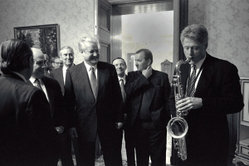
Like clarinets, saxophones use a single reed. Saxophone reeds, though, are generally broader and shorter than clarinet reeds. Hardness is usually (but not always) measured using a numeric scale that ranges from 1 to 6 (though one rarely sees a reed at either end of this spectrum). Unfortunately, this scale is far from standardized, and a Rico 3 is decidedly softer than a Vandoren 3, for example. Some players make their own reeds from 'blanks', but as this is time-consuming and usually requires expensive equipment, most do not. Most players, however, adjust reeds by shaving or sanding. Reed care is a controversial topic among players. Methods for 'breaking in' reeds and opinions about how long they remain playable differ so greatly among players that the topic should, perhaps, be referred to another article. Most players agree that reeds are somewhat inconsistent and require maintenance. Advanced students and professional saxophonists spend years perfecting their methods of reed selection, storage, and adjustment.
Synthetic reeds made of various substances exist, and are used by a small number of saxophonists. Many saxophonists consider them to give poor control, consider their sound uncharacteristic of the instrument, or say they would consider them for use only in a context such as a marching band. On the other hand, synthetic reeds are generally more durable than their natural counterparts, and do not need to be moistened prior to playing. New plastic reeds by the Canadian company Legere are an improvement in technology and have gained a limited acceptance among some players, especially for use in doubling (i.e., playing more than one instrument) when one of the instruments is played intermittently (during which time a natural reed might become dry).
Writing for the saxophone
Music for the saxophone is written on the treble clef. The standard written range extends from a B-flat below the staff to an F# three ledger lines above the staff. Higher notes -- those in the altissimo range (ranging from high F# or above) -- can also be played using harmonics and cross fingerings. Sax himself demonstrated the instrument with over three octaves.
Sopranino, alto and baritone saxophones are in the key of E-flat, and soprano, tenor and bass saxophones are in the key of B-flat. Because the saxophone is a transposing instrument, it is easy for a player to switch between instruments because the fingerings remain the same for the same written notes. When a saxophonist plays a C on the staff on an E-flat alto saxophone, the note sounds as E-flat a sixth below the written note; on a B-flat tenor saxophone, the note sounds as B-flat a ninth below. The E-flat baritone is an octave below the alto, and the B-flat soprano an octave above the tenor. The following discussion refers entirely to the notes as written, and therefore applies equally to all members of the saxophone family.
Late-model baritone saxophones have a low A-natural, but other members of the family do not (except for a limited number of Selmer Mark VI altos 1), and composers who write this note for baritone should be aware that it may not actually be played if the saxophonist uses an older instrument.
Members of the family
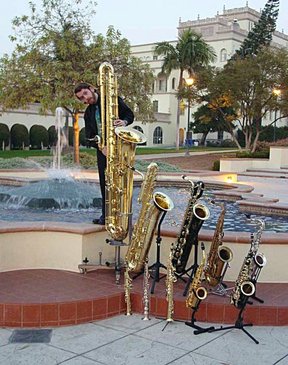
The saxophone was originally patented as two families, each of seven instruments. The "orchestral" family consisted of instruments in the keys of C and F, and the "military band" family in E-flat and B-flat. Each family consisted of sopranino, soprano, alto, tenor, baritone, bass and contrabass, although some of these were never made; Sax also planned--but never made--a subcontrabass instrument.
Of the orchestral family, only the tenor in C, soprano in C, and mezzo-soprano in F (similar to the modern alto) ever gained popularity. The tenor in C, generally known as the C melody saxophone, was very popular among amateurs in the 1920s and 1930s, because players did not need to transpose. Although the instrument was popularized by players such as Rudy Wiedoeft and Frank Trumbauer, it did not secure a permanent place in either jazz or classical music. The instrument is now a commonly encountered attic or garage sale relic, though since the 1980s several contemporary and classical saxophonists have begun to utilize the instrument once again.
Also in the early 20th century, the C soprano (pitched a whole step above the B-flat soprano) was marketed to the amateur market as well as those who wished to perform oboe parts in military band and vaudeville arrangements. C sopranos will ocasionally be found in music stores. The mezzo-soprano in F (produced by the American firm Conn) is quite rare and is usually found in the possession of a serious instrument collector; its only notable exponent is the multi-instrumentalist Anthony Braxton. Manufacture of these three sizes largely ceased prior to World War II, though a similar instrument, the contralto saxophone, was developed in the late 20th century by California instrument maker Jim Schmidt; this instrument has a larger bore and a new fingering system so it does not resemble the C melody instrument except for its key and register.
Of the military band family, only the soprano, alto, tenor and baritone are in common use (these form the typical saxophone sections of both military and big bands). The bass saxophone is also sometimes used in band music (especially that of Percy Grainger). The alto saxophone is the most popular among classical composers and players. The soprano has regained a degree of popularity over recent decades, beginning first with the work of jazz saxophonist John Coltrane, and the bass, sopranino and even contrabass are still manufactured. Sopranino, bass and contrabass are rarely used except in large saxophone ensembles and saxophone orchestras.
At the other end of the spectrum, construction difficulties mean that only recently has a true sopranissimo saxophone been produced. Nicknamed the soprillo, this piccolo-sized saxophone is an octave above the soprano, and its diminutive size necessitates an octave key on the mouthpiece.
Related instruments
A number of saxophone-related instruments have appeared since Sax's original work, most enjoying no significant success. These include the saxello, similar to a straight soprano but with a slightly curved neck and tipped bell; the straight alto; and the straight tenor (currently the exclusive domain of LA Sax). Since a straight-bore tenor is approximately five feet long, the cumbersome size of such a design hinders both playing the horn (particularly when seated) and carrying it. As of 2005, original H. N. White King saxellos command prices up to US$4,000. A number of companies, including Rampone & Cazzani and Woodwind and Brasswind, are marketing straight-bore, tipped-bell soprano saxophones as saxellos (or "saxello sopranos").
Two of these variants were championed by jazz musician Rahsaan Roland Kirk, who called his straight alto a stritch and his modified saxello a manzello; this unique instrument featured a larger-than-usual bell and modified keywork.
The tubax, developed in 1999 by the German instrument maker Benedikt Eppelsheim, plays the same range, and with the same fingering, as the E-flat contrabass saxophone; its bore, however, is narrower than that of a contrabass saxophone, making for a more compact instrument with a "reedier" tone (akin to the double-reed contrabass sarrusophone).
Another unusual variant of the saxophone was the Conn-O-Sax, a straight-bore instrument in F (one step above the E-flat alto) with a slightly curved neck and spherical bell. The instrument, a hybrid of the saxophone, english horn, and heckelphone, was intended to imitate the timbre of the english horn and was produced only between 1928 and 1930. The instrument had a key range from low A (as with a modern baritone saxophone) to high G, a note which is now found on some soprano saxophones.
Although not true saxophones, inexpensive keyless folk versions of the saxophone made of bamboo were developed in the 20th century by instrument makers in Hawaii, Jamaica, Argentina, Thailand, and Indonesia. The Hawaiian instrument, called xaphoon, is also marketed as a "bamboo sax" although its cylindrical bore more closely resembles that of a clarinet. Jamaica's best known exponent of a similar type of homemade bamboo "saxophone" was the mento musician and instrument maker Sugar Belly (William Walker). In the Minahasa region of the Indonesian island of Sulawesi, there exist entire bands made up of bamboo "saxophones" and "brass" instruments of various sizes, a clever imitation (using local materials) of European instruments introduced by the Dutch during colonial times.
The saxophone in ensemble
Besides functioning as a solo instrument, the saxophone is also an effective ensemble instrument, particularly when several members of the saxophone family are played in combination. Although only occasionally called for in orchestral music, saxophone sections (usually encompassing the alto, tenor, and baritone instruments but sometimes also the soprano and/or bass) are an important part of the jazz big band, as well as military, concert, and marching bands.
Ensembles made up exclusively of saxophones are also popular, with the most common being the saxophone quartet (comprising the soprano, alto, tenor, and baritone instruments, or, more rarely, two altos, tenor, and baritone). There is an extensive repertoire of classical compositions and arrangements for this instrumentation dating back to the nineteenth century, particularly by French composers. The Raschèr, Amherst, and Rova Saxophone Quartets are among the most well known groups, and the World Saxophone Quartet is the preeminent jazz saxophone quartet.
Larger all-saxophone ensembles exist as well, with very large groups sometimes organized for the finales of saxophone conventions. The most prominent professional saxophone ensembles include the Rascher Saxophone Orchestra, London Saxophonic, Nuclear Whales Saxophone Orchestra, and Urban Sax.
Technique
Playing technique for the saxophone is subjective based upon the intended style (classical, jazz, rock, funk, etc.) and the player's idealized sound. The design of the saxophone allows for incredibly varied tone-production, and the "ideal" saxophone sound and keys to its production are subjects of heated debate. However, there is a basic underlying structure to most technique.
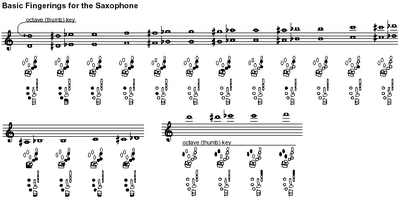

Growling is a technique used whereby the saxophonist sings or hums while playing. This causes a modulation of the sound, and results in a gruffness or coarseness of the sound. It is rarely found in classical or band music.
A glissando or sliding technique can also be used. Here the saxophonist bends the note using the embochure and at the same time slides up or down to another fingered note. This technique is also used on the clarinet and is sometimes heard in big band music (ie. Benny Goodman's "Sing Sing Sing") and orchestral scores (the most famous example being the opening solo clarinet line in George Gershwin's "Rhapsody in Blue"). A glissando can also be made controlling the air stream, sliding between the harmonics. Especially in the higher register a pure glissando from second octave A upwards is easier than lower notes.
Another technique used for producing a different sound is known as "overtones" and involves fingering one note but sounding another note which is an overtone of the fingered note. For example if low Bb is fingered, a Bb one octave above may be sounded by manipulating the throat cavity. The Bb one octave higher is the first overtone of the low Bb. The next three overtones of the low Bb are F, Bb, and D. Harmonics are also used to gain access to the altissimo register.
Embouchure
In the typical embouchure, the mouthpiece is generally not taken more than half-way into the player's mouth. The bottom lip is generally curled in slightly (though some players choose to turn the lip outward) and the mouthpiece is rested upon it, held firm with light pressure from the upper teeth resting on the mouthpiece (sometimes padded with a thin strip of rubber known as a "bite-pad"). The upper lip closes to create an air-tight seal, and the corners of the mouth are kept firm and pulled up towards the nose as the head is tilted down to straighten the neck and thus the air-current.
Imperative to a full and quick-speaking sound is the position of the throat. The throat should feel open, almost stretching wide, as when yawning or when blowing air on one's hands. This openness should remain constant throughout the register of the saxophone, especially the low register (D down to Bb [or A if available]). The exception to the rule comes at 3rd octave E and up into altissimo, where the throat should change to an "eeee" position to maximize the fullness of sound.
See also
References
- Teal, Larry (1963). The Art of Saxophone Playing. Miami:Summy-Birchard. ISBN 0-87487-057-7
External links
- The International Saxophone Home Page
- Sax on the Web Lessons, tips, articles, and discussion forum.
- Introduction to Saxophone acoustics
- Saxophone fingering chart
- SaxTalk Saxophone news and articles.
- alt.music.saxophone/rec.music.makers.saxophone Frequently Asked Questions One of the first Saxophone FAQs on the web, written by Mike Wells.
